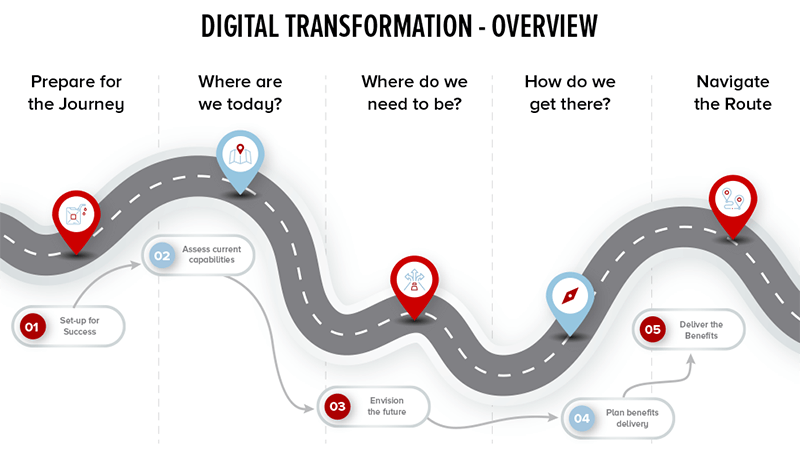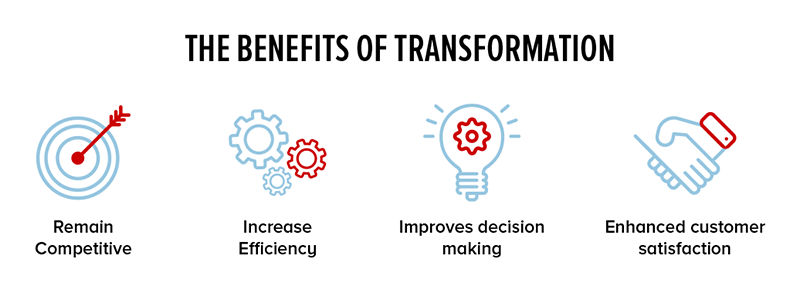Digital transformation means hard‑wiring digital platforms, data‑driven thinking and automation into every business process so the company can pivot fast, monetise customer data and roll out new business models. A solid 2025 strategy links tech investments to specific outcomes, is steered by a cross‑functional team and evolves continually rather than launching once and stopping.
Put simply, a digital business is any company that’s built to thrive in the new, digital-first economy. Digital businesses can and do adapt quickly, and they don’t let bureaucracy or red tape stop them from innovating and making needed changes.
Digital businesses have fully embraced digital transformation, recognizing that a digital-first framework is key to surviving and thriving in today’s digital landscape.
Data is one key factor driving digital transformation: businesses face an existential need to understand and leverage the data they already have (and collect better data moving forward). Their legacy systems and processes can’t accomplish this for them, so they turn to newer models and approaches.
Additionally, we’ve identified three critical initiatives to drive digital transformation, each of which can act as a driver:
• Implementing effective change management: digital transformation brings plenty of change
• Customer experience as a differentiator: digital transformation can drive improvements in CX
• The need for automation: automation (such as RPA and BPO) can alleviate staff shortages and replace inefficient manual processes
Culture can be another driving force — or it can be a hindrance.
A business’s existing culture must be considered before engaging in digital transformation. Traditional command-and-control business cultures may achieve compliance, but they may lack the spirit of innovation that makes digital transformation successful.
It’s common to encounter some resistance: you always will when disrupting the status quo, and the idea of automation may frighten some employees who fear for their jobs.
The more traditional or unreceptive to creative thinking an organisation, the more resistance against digital transformation is likely. But the more a business is already fostering a culture of innovation, the better prepared they are from a culture standpoint to make the bold changes that digital transformation requires.
Many business leaders are concerned about a return on investment from any digital transformation initiative. This isn’t always easy to measure given the wide-ranging, cross-functional nature of any significant transformation.
The best measure of ROI is a holistic, portfolio-wide view. Digital transformation can be messy, and individual projects or small initiatives may underperform or even fail. Evaluating each project or piece on a standalone basis leads to premature cancellation and a lack of commitment to business transformation. The better view is to look at the entire state of operations, asking questions such as these:
• Is customer experience improving?
• Are you seeing revenue growth, LCV improvement, or other financial improvements?
• Are you gaining new efficiencies, or even entirely new capabilities?
• Do you see progress in the strength of business processes?
• Are you better positioned to gain from new technologies, including those that haven’t been developed yet?
Even more importantly, measuring ROI may be the wrong focus to begin with. Digital transformation is for many businesses an existential need: the last among a group of competitors to make the move well may be the first to decline or even exit the market.
Detangle the automation journey with a guide to start your automation strategy in this free-to-use tool and personalised report.
Get startedIf your organisation is ready to pursue digital transformation — or even if you’re simply exploring the idea at this point — formulating a strategy unique to your needs and culture is essential. No single strategy will be perfectly aligned for every business: you don’t need the same transformations as a business in an entirely different field. We’ll outline several strategy steps below, but these certainly must be customised to fit your business. (We at Canon Business Services ANZ (CBS) will be glad to assist you in this process as well.)
Before beginning in earnest, your leadership team must align strategically, answering both the “what” the “why” of the initiative. What is included in the scope of digital transformation? Why is the company entering into the process? What outcomes are necessary? What are beneficial? What are the risks of not committing to the project?
Once leadership is aligned on overall strategy, it’s time to spread that message throughout the organisation.
Businesses already operating with a culture of innovation may simply need to inform the rank and file of the upcoming transition. Others will have cultural work to do to prepare teams for a significant disruption to the status quo.
Third, organisations must analyse current systems to determine what can and cannot come along on the transformation. Some legacy systems and tools may need to be abandoned or replaced; others can come along as is or with modifications.
This is also the time to inventory analogue (paper) documents and records. Digital transformation must include the digitisation of these documents. Our Digitisation team would be happy to assist with bulk document scanning, helping you unlock the data into actionable digital insights.

With an understanding of what must occur and which systems need to be updated or replaced, you’re ready to build a technology and process roadmap. Mapping out operational processes here is vital because this initiative isn’t about bolting new technology onto the old ways of doing things. Some old ways of doing things need to go, and that’s going to require a roadmap.
This is where the right IT partner (or lack thereof) can make or break a digital transformation: it’s rare for any organisation to have sufficient internal knowledge of the market and what’s possible in transitions like these, so going it alone often leaves significant opportunities on the table.
Digital transformation doesn’t happen all at once. A smart strategy begins incrementally, with smaller projects that can be easily measured for ROI, progress, and outcomes.
As you find incremental success, it’s time to roll out a fuller implementation. Here again it’s vital to partner with vendors and IT partners that can make your implementation the best it can be.
Last, recognize that, as with any large-scale change, you will not get every element perfect the first time. After implementation, gather data on what’s working, what’s broken, and what’s somewhere in between. Then refine your plan and iterate until you find an optimal balance.
After that point you’ll need to continue iterating, because digital transformation never fully stops. As the digital age (especially the internet of things) continues to evolve, so will your digital transformation plan.
CBS has guided numerous businesses and enterprises through their digital transformations. We understand what it takes to get there — and we know how powerful a change it can be. Evolving your approach will improve agility, efficiency, customer experience—even staff morale as they are freed from monotonous tasks and given the capacity to create and innovate.
Read about what CBS has accomplished in terms of digital transformation in the financial services industry, or check out a case study in the healthcare industry.
Is digital transformation the next step in your company’s evolution? Canon Business Services ANZ can guide you from where you are to where you seek to be. Reach out to our team to begin your journey.

We’ve covered many aspects and angles of digital transformation, except for one: what it looks like in the real world.
Here are a few examples of companies that used digital transformation to achieve specific goals.
Global agriculture giant Monsanto embarked on a digital transformation process in the mid 2010s. Speaking to the Enterprisers Project in 2018, then-CIO James Swanson explained that the company defined digital transformation in terms of customer centricity. Yes, they automated operations and explored new ways of doing things. Yes, they leveraged data to discover new insights about their operations. But at the heart of it all was the customer.
Swanson got buy-in from team members by explaining the outcomes digital transformation was likely to achieve: increased net promoter scores, reduced churn, lowered carbon footprint, and so forth.
With digitally transformed data analytics, Monsanto eliminated 1.4 million miles of road driving by making its transportation, storage, and distribution operations more efficient. This savings translates into cost savings and faster order delivery, both of which increase customer satisfaction.
Tech giant Microsoft might seem like it shouldn’t have needed digital transformation— after all, hasn’t it been digital all along?
But it did.
In the early 2010s the company was viewed primarily as a software and OS maker, along with backend business services. The company embraced the principles of digital transformation as it evolved into a cloud computing and networking-focused organisation.
Practical results here included growing Office into Microsoft 365, a much more robust cloud-based subscription product. Some of the tools businesses currently use every day may have seemed unthinkable internally at Microsoft a decade ago. But the company changed its approach, adjusted its culture, and built a new, more successful technology.
As we wrap up this post, consider these 2024 best practices as you begin the digital transformation journey at your company.
• Start small: this journey takes time, and small, early wins will propel you forward to larger ones.
• Answer the “why”: know the reason you’re doing this, the outcomes or driving motivations behind the change.
• Address the culture: if digital transformation is new for your business, don’t assume everyone will understand or be on board. Work on your culture first.
• Iterate: you won’t get it all right the first time, and that’s OK. Learn from what worked and what didn’t as you iterate.
Digital transformation in 2025 means embedding AI, automation, and data-first thinking into every process to improve agility, customer experience, and operational efficiency. For Australian businesses, it also involves navigating local compliance, modernising legacy systems, and preparing for rapid market shifts. It's no longer just about adopting new tools—it's about rethinking how your organisation delivers value in a digital-first economy.
In 2025, key trends include AI-powered process automation, hyper-personalised customer experiences, secure cloud migration, and real-time data analytics. Australian companies are also focusing on ESG reporting automation and cybersecurity upgrades to meet tightening regulatory standards. Businesses that connect these trends to clear outcomes—like reducing costs or improving CX—will lead their industries.
Measure digital transformation ROI through improvements in customer satisfaction (NPS, churn), operational efficiency (cost savings, automation impact), and revenue growth (new channels, upsell success). Focus on portfolio-level gains, not just individual project wins. Set clear KPIs upfront, track progress quarterly, and refine continuously to stay aligned with evolving goals.
Culture is the make-or-break factor in digital transformation. Even the best tech fails without buy-in from teams. A culture that supports experimentation, agile thinking, and data-based decisions accelerates change. Leaders must promote transparency, reskill teams, and create a safe environment for innovation—especially in traditionally risk-averse sectors like finance and healthcare.